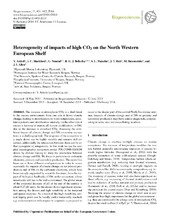Heterogeneity of impacts of high CO2 on the North Western European shelf
Artioli, Yuri; Blackford, Jerry C.; Nondal, Gisle; Bellerby, Richard; Wakelin, Sarah L.; Holt, Jason T.; Butenschön, Momme; Allen, Julian Icarus
Peer reviewed, Journal article
Published version
Permanent lenke
https://hdl.handle.net/1956/10450Utgivelsesdato
2014-02-03Metadata
Vis full innførselSamlinger
- Geophysical Institute [1198]
Originalversjon
https://doi.org/10.5194/bg-11-601-2014Sammendrag
The increase in atmospheric CO2 is a dual threat to the marine environment: from one side it drives climate change, leading to modifications in water temperature, circulation patterns and stratification intensity; on the other side it causes a decrease in marine pH (ocean acidification, or OA) due to the increase in dissolved CO2. Assessing the combined impact of climate change and OA on marine ecosystems is a challenging task. The response of the ecosystem to a single driver can be highly variable and remains still uncertain; additionally the interaction between these can be either synergistic or antagonistic. In this work we use the coupled oceanographic–ecosystem model POLCOMS-ERSEM driven by climate forcing to study the interaction between climate change and OA. We focus in particular on carbonate chemistry, primary and secondary production. The model has been run in three different configurations in order to assess separately the impacts of climate change on net primary production and of OA on the carbonate chemistry, which have been strongly supported by scientific literature, from the impact of biological feedbacks of OA on the ecosystem, whose uncertainty still has to be well constrained. The global mean of the projected decrease of pH at the end of the century is about 0.27 pH units, but the model shows significant interaction among the drivers and high variability in the temporal and spatial response. As a result of this high variability, critical tipping point can be locally and/or temporally reached: e.g. undersaturation with respect to aragonite is projected to occur in the deeper part of the central North Sea during summer. Impacts of climate change and of OA on primary and secondary production may have similar magnitude, compensating in some area and exacerbating in others.

